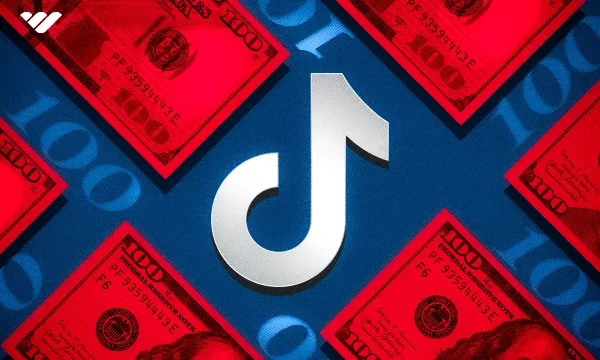User-generated content has become one of the most compelling forms of content—and for a good reason. The proliferation of content has made it hard for brands to stand out. To overcome this challenge, they started looking for authentic content that would endorse their products without sounding too salesy.
Here’s where user-generated content (UGC) comes into the picture. There’s no doubt that UGC is modern-day word-of-mouth marketing, and it increases purchase confidence.
But what is user-generated content, what are the different types of UGC, and how to successfully run a UGC campaign? In this article, we’ll answer these questions and more. Let’s dive in.
What is UGC (User-Generated Content)?
User-generated content (UGC) is any form of original content created by customers and published on social media or other channels. There are many different forms of UGC, including images, videos, product reviews, testimonials, and every other content that promotes a brand.
According to a survey from EnTribe, 77% of shoppers are more likely to buy a product they found through UGC. That’s good news for brands because the need for fresh content is always on the rise. Without UGC, brands would not be able to produce the amount of content they need daily without becoming a full-time content production company.
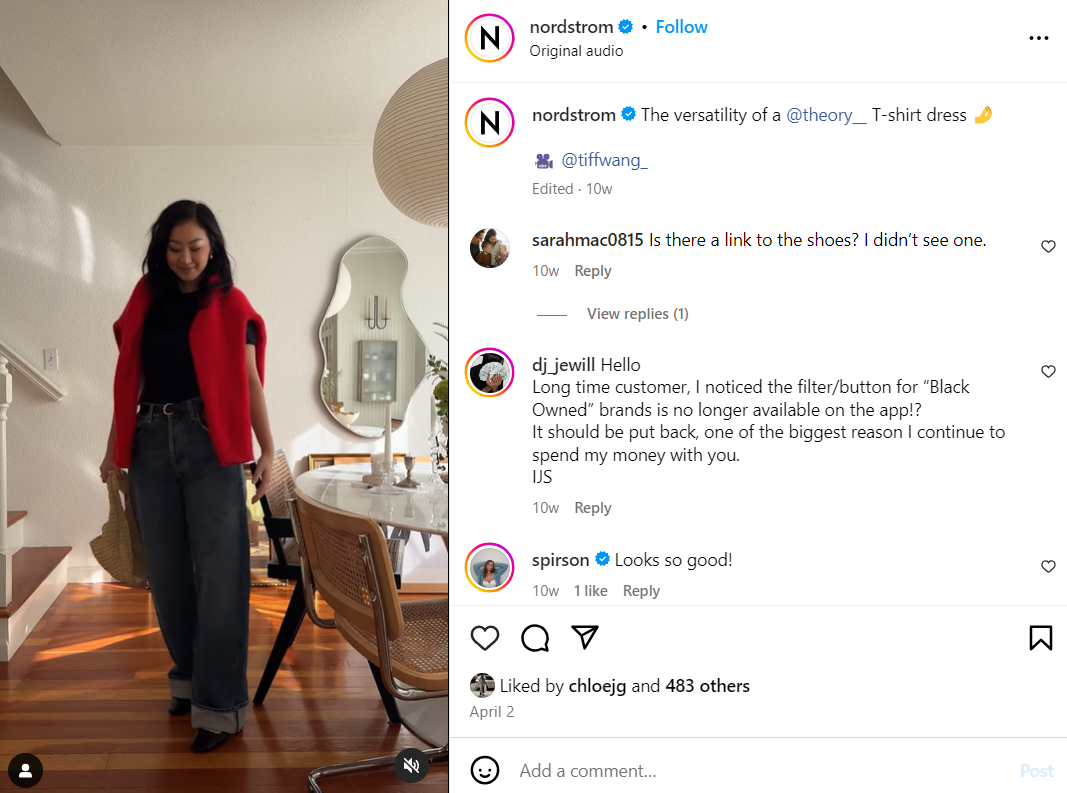
The bottom line is that user-generated content offers the most scalable way for brands to showcase products authentically.
What is a UGC creator?
A UGC creator is a creator who produces original images, videos, reviews, comments, or other forms of media to document a personal experience with a product, service, or brand.
The difference between UGC creators and influencers is that UGC creators produce original, unbiased content that aims to share experience, add value, or educate and usually serves as social proof. Regarding influencers, their content is usually part of a scripted and pre-shot campaign to promote a product or a brand and influence people’s buying decisions.
The rise of the creator economy has democratized content creation, allowing UGC creators to monetize their efforts. Now, we can see creators getting paid by brands to share their genuine feedback on a product and create content brands can use on their channels and platforms.
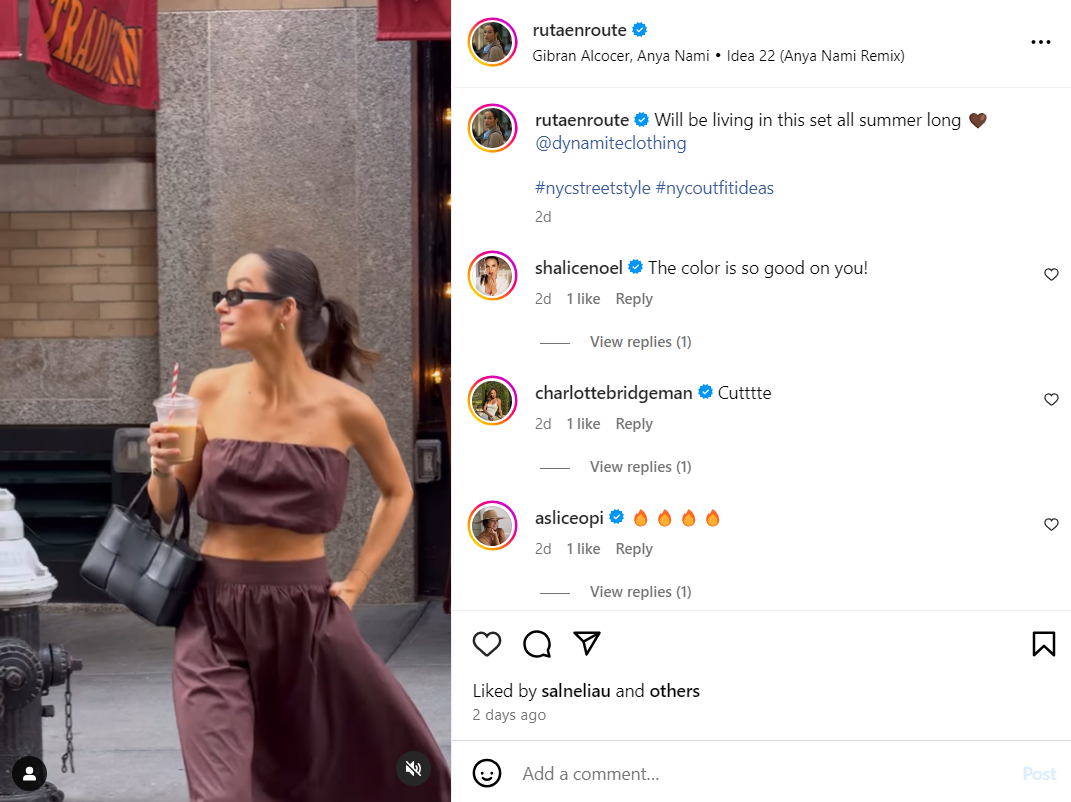
6 Different Types of UGC
User-generated content (UGC) is much more than an Instagram post from a loyal customer. Depending on the form, it can be text, image, or video. If we look at the creation process, UGC can be organic or paid.
Let's take a look at all the different types of UGC that you can use for your brand, starting with four types of organic UGC.
Organic UGC
Organic user-generated content helps the brand gain trust and capture customers’ attention. It talks about the product or shows how it’s used without a strong call-to-action that pushes people to make a purchase. Organic UGC comes in many different forms, from reviews and testimonials to photos, videos, and social media posts.
Reviews and testimonials
Reviews and testimonials are customer statements about a product or service they’ve used and their experience with it. They are the ultimate social proof that often serves as the last reassurance that customers are making the right decision when purchasing a product.
Reviews and testimonials have become a major part of the purchase-making decision process, too. According to PowerReviews, 98% of shoppers say reviews are essential when making purchase decisions. Moreover, nearly half (45%) of consumers won't purchase a product if there are no reviews available for it.
Reviews and testimonials can be particularly helpful for selling digital products, as users would want to hear a first-hand experience from others who have already purchased the product in the past.
Creator HQ is an all-in-one workspace that helps creators save time and create more content. By displaying testimonials on its homepage, it shows experiences from other users and encourages new creators to buy it.
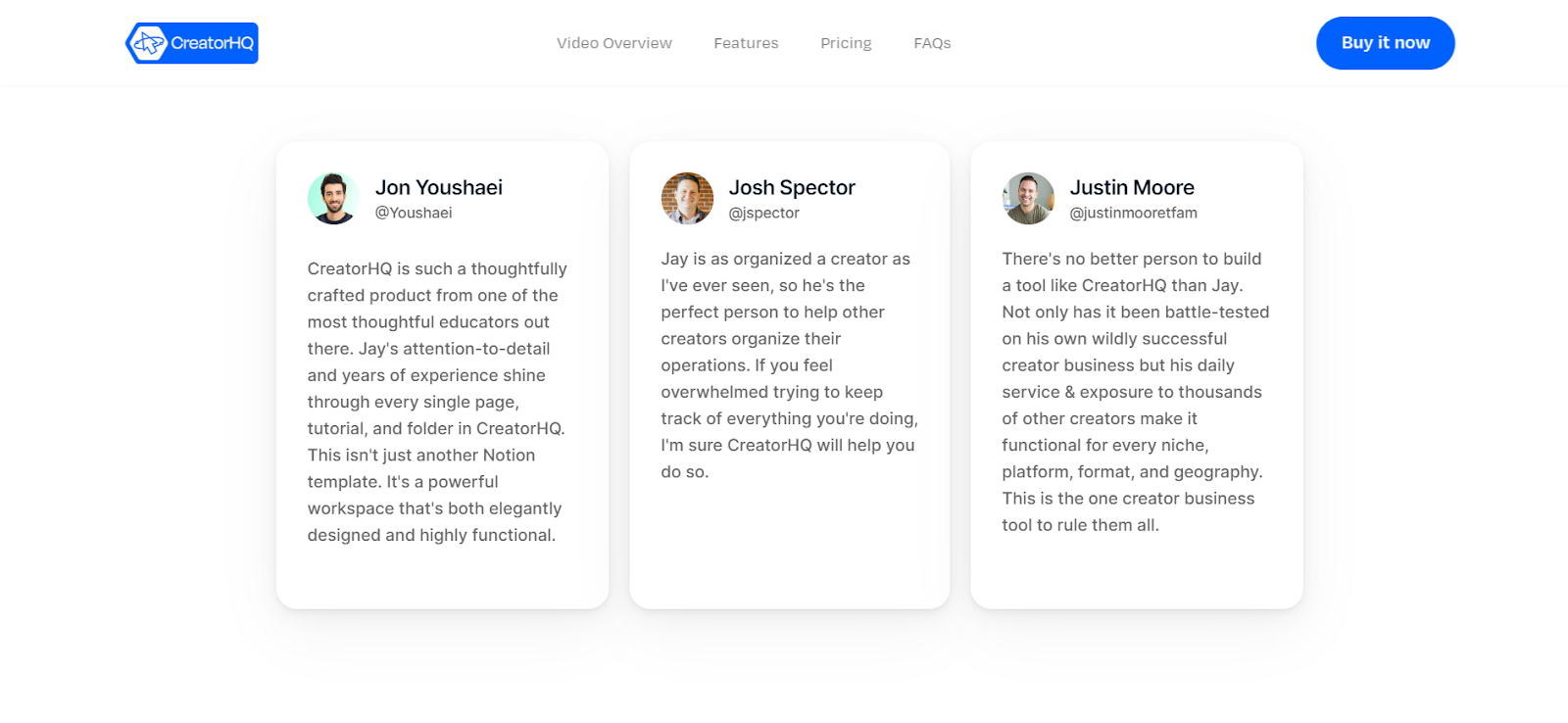
Videos
Our social media feeds are flooded with video content nowadays. Video has taken primacy as the most frequently used media form. The reason is simple — it works. Data from Wyzowl shows that 82% of people have been convinced to buy a product or service by watching a video.
YouTube product reviews have become very popular over the years. Creators show how they use a product and share their honest opinions. These videos give customers all the answers they have about a product, which removes a burden off their shoulders before they click the “add to cart” button.
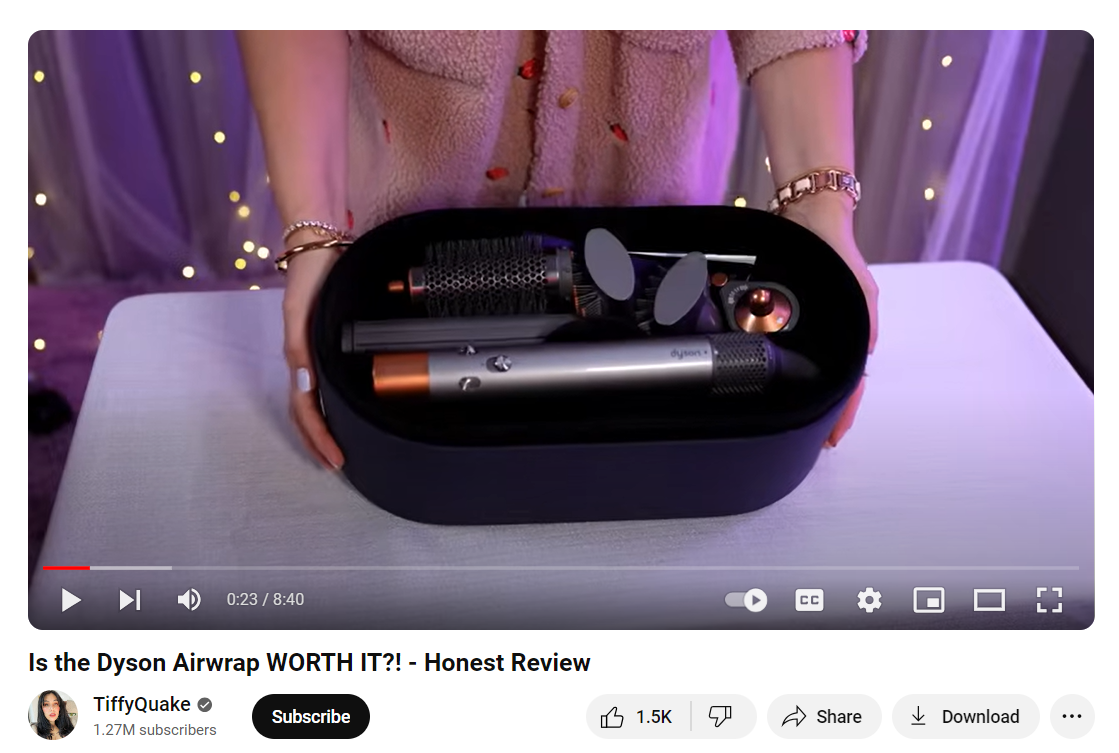
While videos are extremely popular for reviewing physical products, plenty of users also share their experiences with buying digital products. And it makes sense—people who want to invest their money in buying a digital product would love to hear an honest review of the overall experience and the benefits.

Photos
Photos are another popular type of organic user-generated content. Brands create specific hashtags and ask customers to tag them when posting content on their social media channels so they can later repurpose the content.
User-generated content is a breath of fresh air in a world of over-edited photos, filters, and AI. Brands even go one step further. Lovesac, for example, has created a customer gallery on its website where customers can add photos of their products and thus showcase authentic, user-generated content.
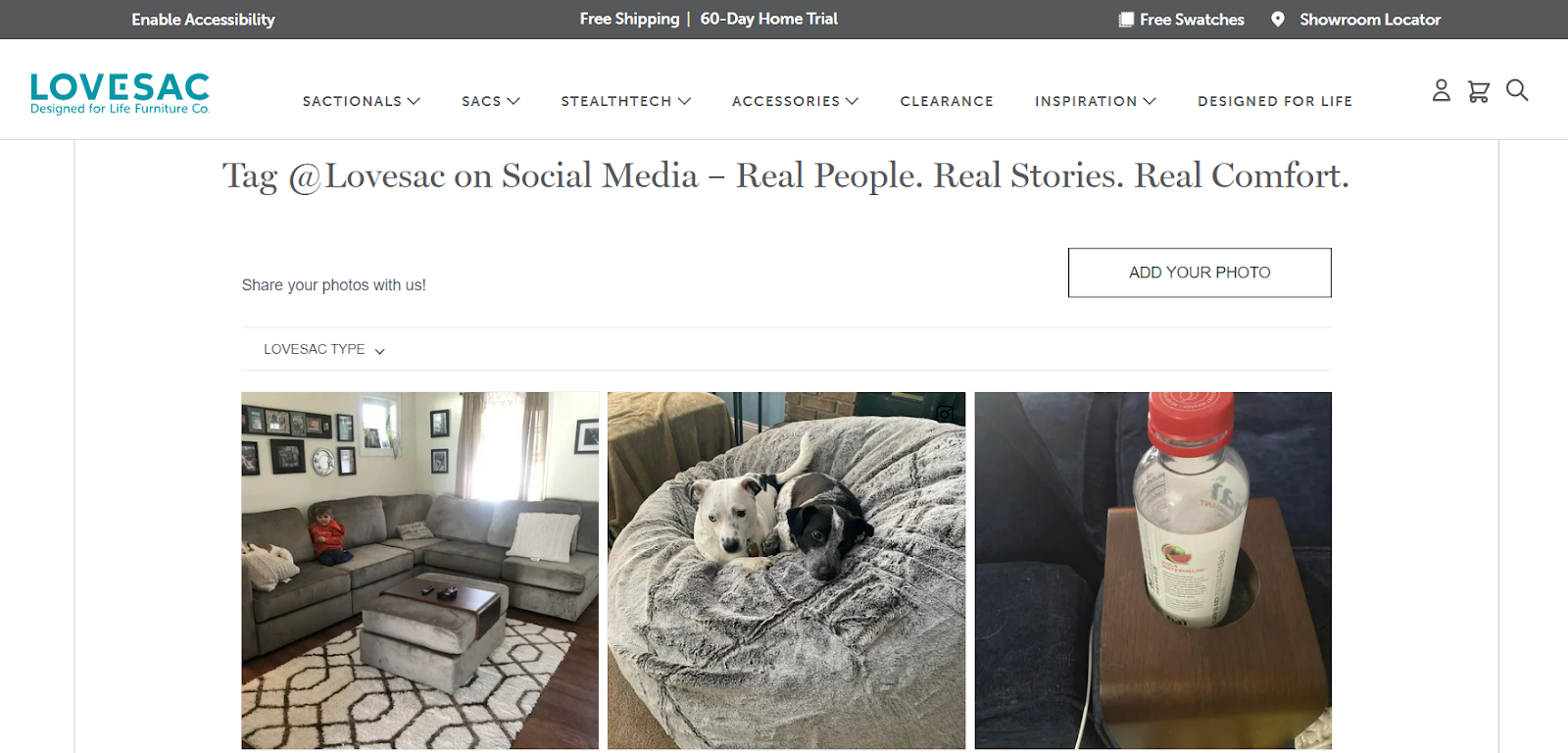
Social media posts
One of the biggest challenges is getting customers to post user-generated content more frequently. Drunk Elephant created the hashtag #barewithus to encourage customers to share their photos on social media and get featured on the official Drunk Elephant account.
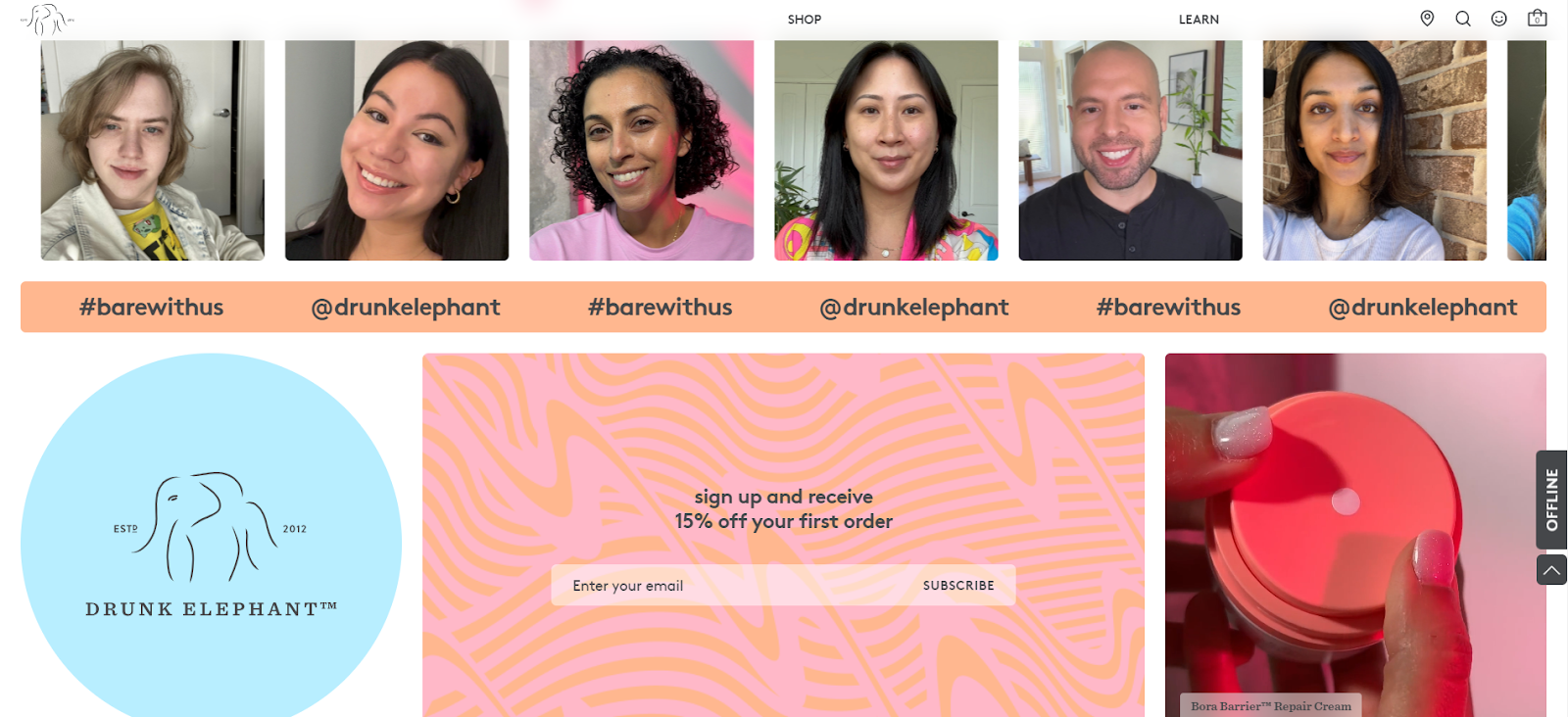
The brand later uses UGC photos and videos to show authentic experiences and honest reviews from its customer base.
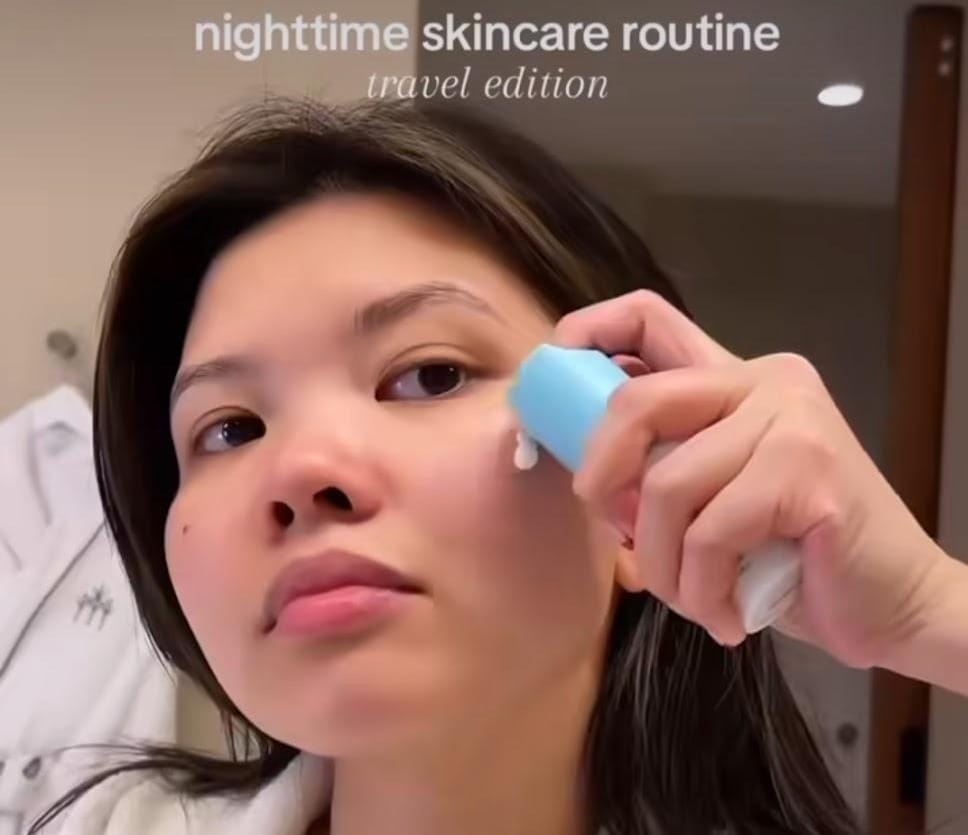
Paid UGC
Unlike organic UGC, which aims to raise brand awareness and spark customers’ curiosity, paid UGC is focused on increasing sales. To measure the success of paid UGC brands, focus on conversion rates, website clicks, sign-ups, downloads, etc. Paid UGC can be done in the following ways:
Influencer marketing
Influencer marketing is a marketing approach that relies on creators to promote a product or service in front of their audience. Although it started as a “free” promotion in exchange for a free product, today, influencer marketing has become a full-time job for many creators who earn their living by promoting brands on social media.
The growth of influencer marketing has brought changes to the Federal Trade Commission (FTC) ad disclosure guidelines. According to the FTC, influencers should always make it clear to followers if a post is in a material partnership with the brand, including contracts, family relationships, monetary payments, or free products.
Brands nowadays have a robust influencer marketing strategy supported by a significant marketing budget and a network of influencers. One of those brands is RedBull, which works with influencers frequently to raise brand awareness and get in front of its target audience.
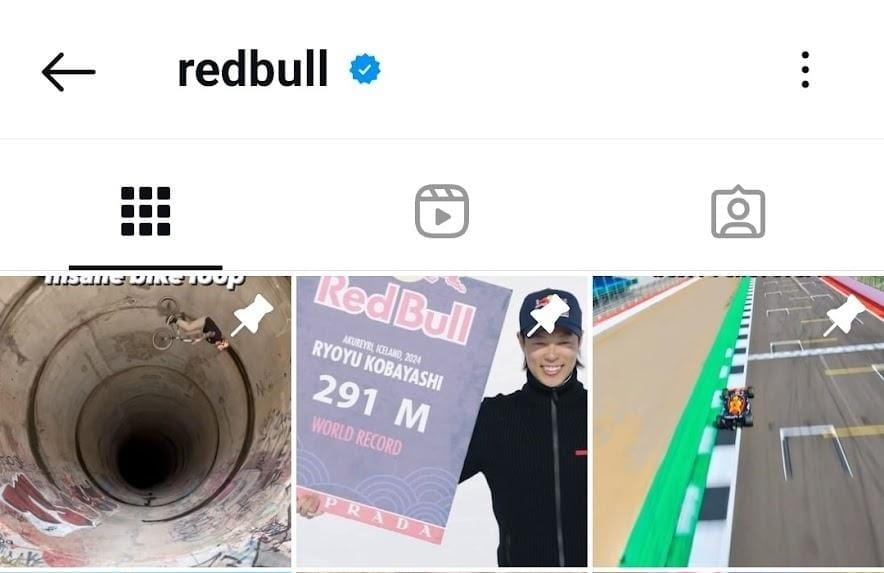
Affiliate marketing
Affiliate marketing is another popular form of paid UGC, which involves collaboration between an “affiliate” and a brand to promote its products (physical or digital products like software) to the affiliate’s audience in exchange for a commission.
Affiliate links are commonly used among fashion and lifestyle content creators, as they get many questions about the products they are using on a daily basis. One of them is Lydia Millen, who regularly shares links to her favorite products across channels, including her blog, YouTube, and social media channels.
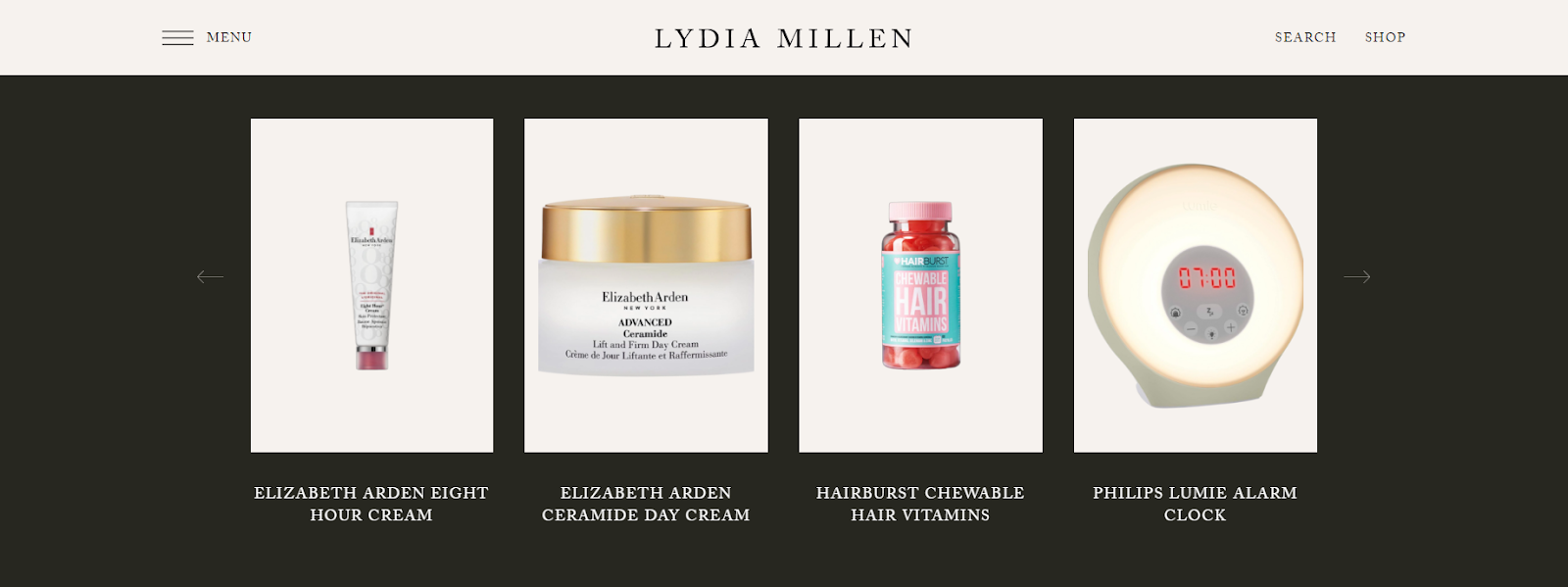
Affiliate marketing is also popular among dropshipping store owners, who share their knowledge on YouTube and give viewers discount codes for opening their own stores. AC Hampton is a famous YouTuber who educates others on starting their dropshipping business. He partnered with Shopify to offer subscribers a 3-day free trial.
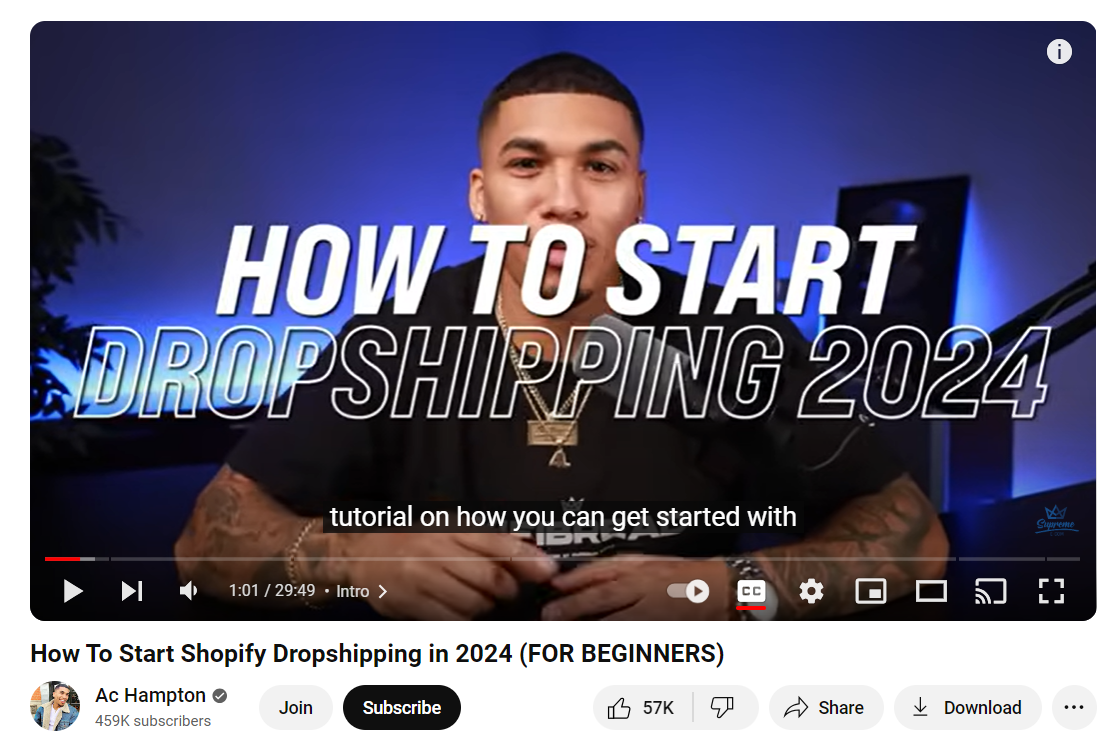
How Valuable is UGC for Businesses?
Customers crave authenticity. They are looking for relatable content. As Seth Godin says, “People like us do things like this.” User-generated content is exactly that—inviting followers to take a peek at the products creators are using and, in a way, inviting them to be a part of that circle. But what are the biggest benefits of using UGC?
- Helps establish an authentic reputation — According to Adweek, 85% of people say UGC is more influential than content made by brands directly. In other words, it helps position a brand as authentic and loved.
- Improves engagement — People tend to engage more with content they perceive as genuine rather than staged, edited, and filtered content.
“Brand-only content can feel like a broadcasted message instead of a conversation. User-generated content, whether through seeding or being a customer/user, feels more engaging than a faceless product.” - Cody Wittick
- Helps diversify content — Creating branded content can be a hurdle. It’s time-consuming and expensive. The good news is that consumers like seeing user-generated content. Data from Accenture shows that 59% of consumers regard UGC as equally entertaining as traditional media.
- Serves as social proof — Showcasing social proof has become a web convention in e-commerce and digital product sales. Leveraging UGC across touchpoints can serve as informational social influence, encouraging consumers to buy a product or a service.
“People buy from people. Being able to have influencers that people respect or just hearing someone’s true feelings towards your product can help efforts across organic social, e-mail, paid media via whitelisting, and more.” - Kendall Dickieson
- Builds trust — Consumers trust UGC more compared to traditional advertising. According to TheDrum, 86% of consumers are more likely to trust a brand that publishes user-generated content, compared to just 12% who are inclined to purchase a product promoted by an influencer.
How to Successfully Run a UGC Campaign in 10 Steps
Running a successful user-generated content campaign can be a powerful way to engage your audience, but the crux of the challenge is to make it authentic rather than promotional. And funny enough, that’s the key to success as well. Here are 10 steps to help you plan, manage, and execute a successful UGC campaign.
1. Define your campaign goals
Start by setting clear objectives and defining your goals with your UGC campaign. Is it to increase brand awareness, drive sales, or foster community engagement? Your objectives will set the tone and shape the direction of your campaign.
Based on your goals, you can answer the following questions:
- What creators would be the perfect fit for the campaign?
- What does your target audience look like?
- What type of content resonates with your target audience?
This step is crucial for setting the right foundation and ensuring you’ll have a successful UGC campaign.
2. Choose platforms
The next step is choosing the platforms that will have the biggest impact on your audience. What platforms do they use frequently, and where are they most active?
Instagram has evolved from an image-sharing app to an engine for influencer marketing and product discovery. TikTok, on the other hand, is a rapidly growing platform for advertisers and content creators alike. Its highly personalized content delivery system keeps users scrolling for hours.
Whether you choose Instagram, TikTok, YouTube, or a combination of platforms, make sure they align with your audience demographics and campaign goals.
3. Prepare content
Once you define your goals and select platforms, it’s time for the fun part—content repurposing. Go through the organic UGC you’ve generated over time and see if it aligns with your brand and campaign theme.
If your campaign also involves paid UGC, define the guidelines and provide inspiration and examples to guide creators through the content creation process. Whether you’re using organic or paid UGC in the form of photos, videos, reviews, or testimonials, make sure you get the necessary permissions from the creators to post the content on your social media channels and platforms.
4. Use hashtags
Next time you contemplate the importance of hashtags on social media, think of the power of #TikTokMadeMeBuyIt. This hashtag has over 8 million posts and influenced millions of purchases of different products that went viral on TikTok.
Aware of its popularity on TikTok, the well-known makeup and beauty brand Benefit Cosmetics uses all the attention and UGC it gets to fuel its email marketing campaigns and boost sales.
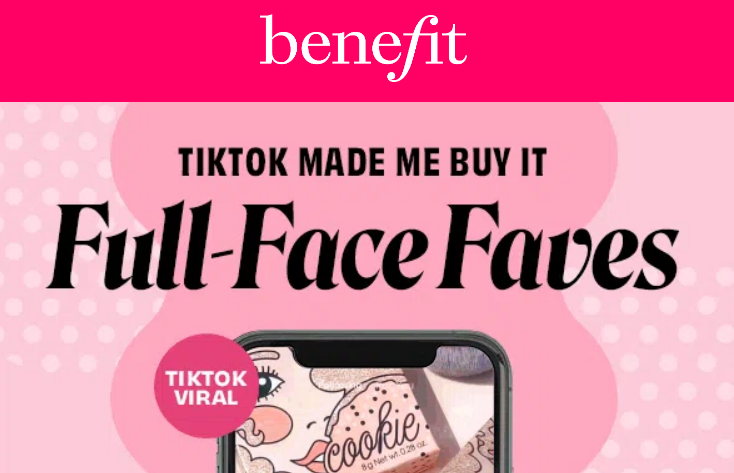
Besides using popular hashtags, you can create a branded hashtag for your UGC campaign to increase visibility, encourage participation, and organize the content you’ll generate. Here are some best practices to consider when creating a branded hashtag for a UGC campaign:
- Make sure it's easy to remember and spell
- Create guidelines for campaign participants
- Ensure the hashtag is relevant to your brand
- Feature the hashtag in your campaign content (visuals, graphics, texts)
- Use the hashtag consistently
- Track the performance of your hashtag
5. Start a trend
Social media is a marketing powerhouse. Not only can it help you connect with your audience, but it can also make your brand a mainstay on people’s feeds. And while opaque social media algorithms make it hard to guess what will go viral and what will collect digital dust, what seems like overnight success requires creativity, strategic planning, and effective execution.
To start a trend on social media that will help you collect UGC, you have to create a compelling and unique concept. This could be a challenge, contest, campaign, or initiative that encourages participation and creativity from your audience.
Too Faced started a TikTok trend to promote its foundation for flawless complexion and created the hashtag #TFBornThisWay. By offering 35 shades that suit a wide range of skin tones and undertones, Too Faced has generated over 400K posts with the branded hashtag.
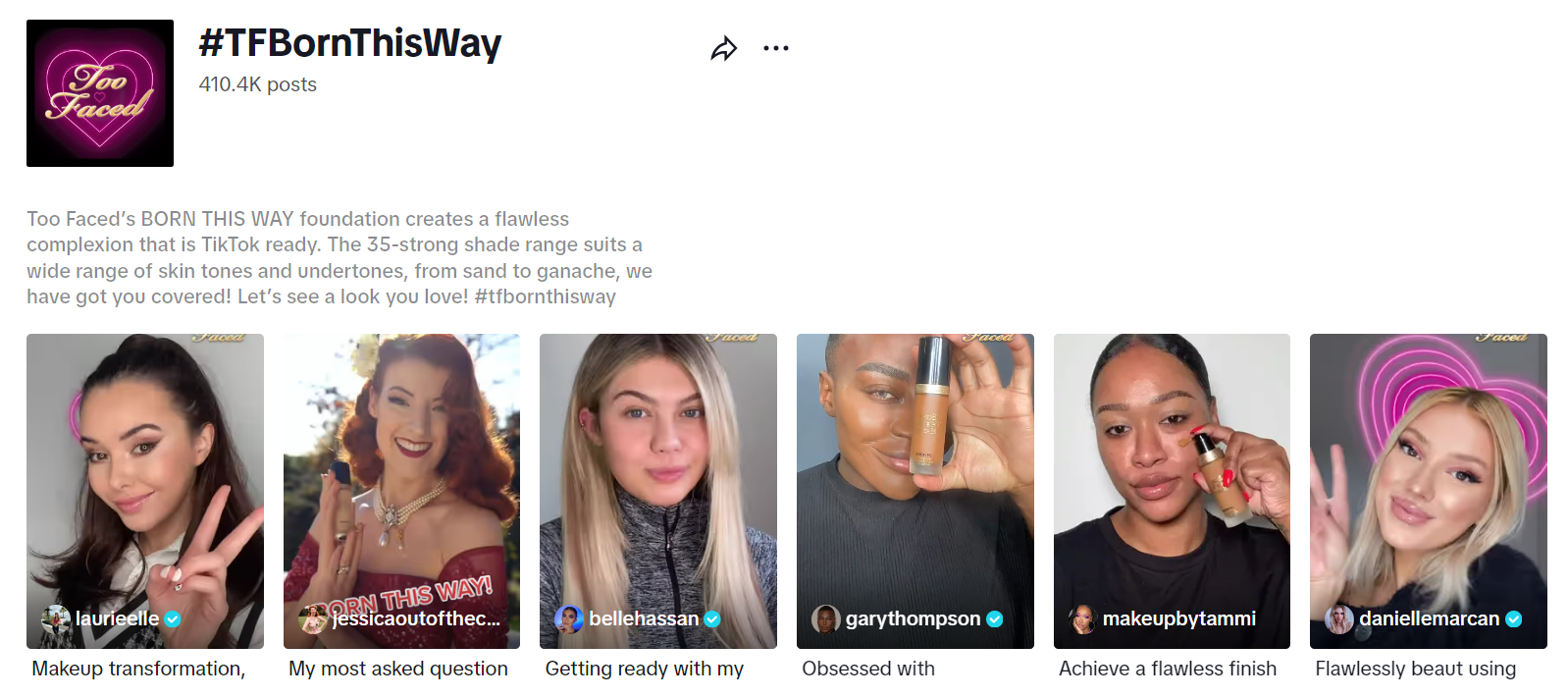
6. Organize a contest (incentives and rewards)
If you want to encourage your audience to participate in the UGC campaign, you have to offer an incentive. Whether that’s a discount, exclusive access, giveaway, or recognition, appealing and relevant incentives can motivate your audience to create UGC and spread the word.
This is what NYX Professional Makeup has done with its #ButterGlossPop challenge, offering participants a chance to win $1200 in makeup. The numbers speak for themselves, as the hashtag has over 1.7M posts on TikTok—a mind-blowing amount of content the brand can repurpose on its social media channels.
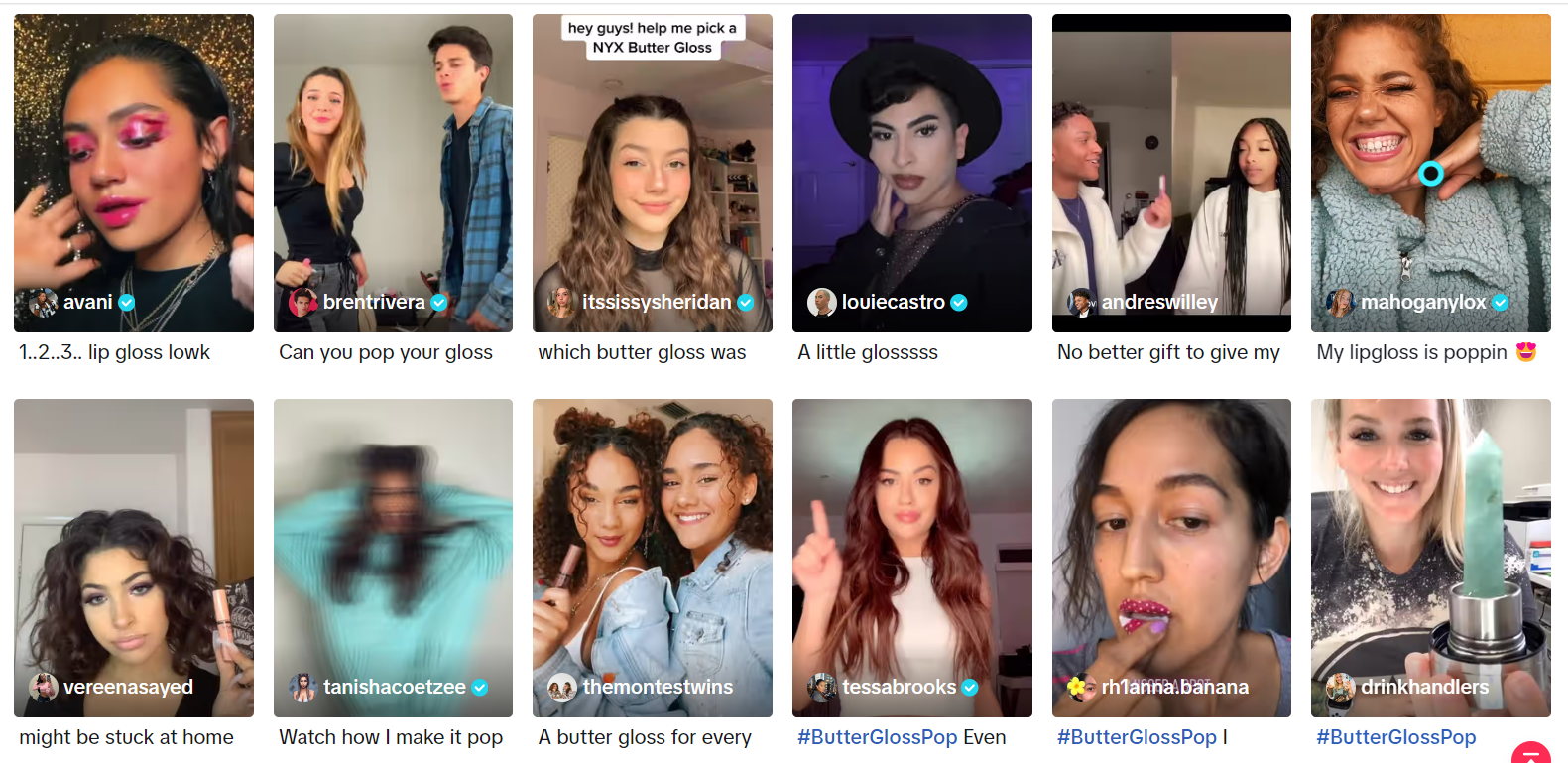
The brand created an original song for the campaign and worked with five TikTok influencers to help it go viral. As Glossy reported, the campaign brought over 10 billion views and boosted brand awareness by 42%.
7. Use UGC across touchpoints
User-generated content is not dedicated only to social media. You can leverage it across different platforms to make the most out of it.
UGC on product pages — The renowned furniture brand Article uses UGC on its product pages to show how other customers style their products in a real-life setting. Seeing high-quality lifestyle imagery is one thing, but seeing the product in other people’s homes brings a different level of inspiration, which might be just what consumers need to make a decision.
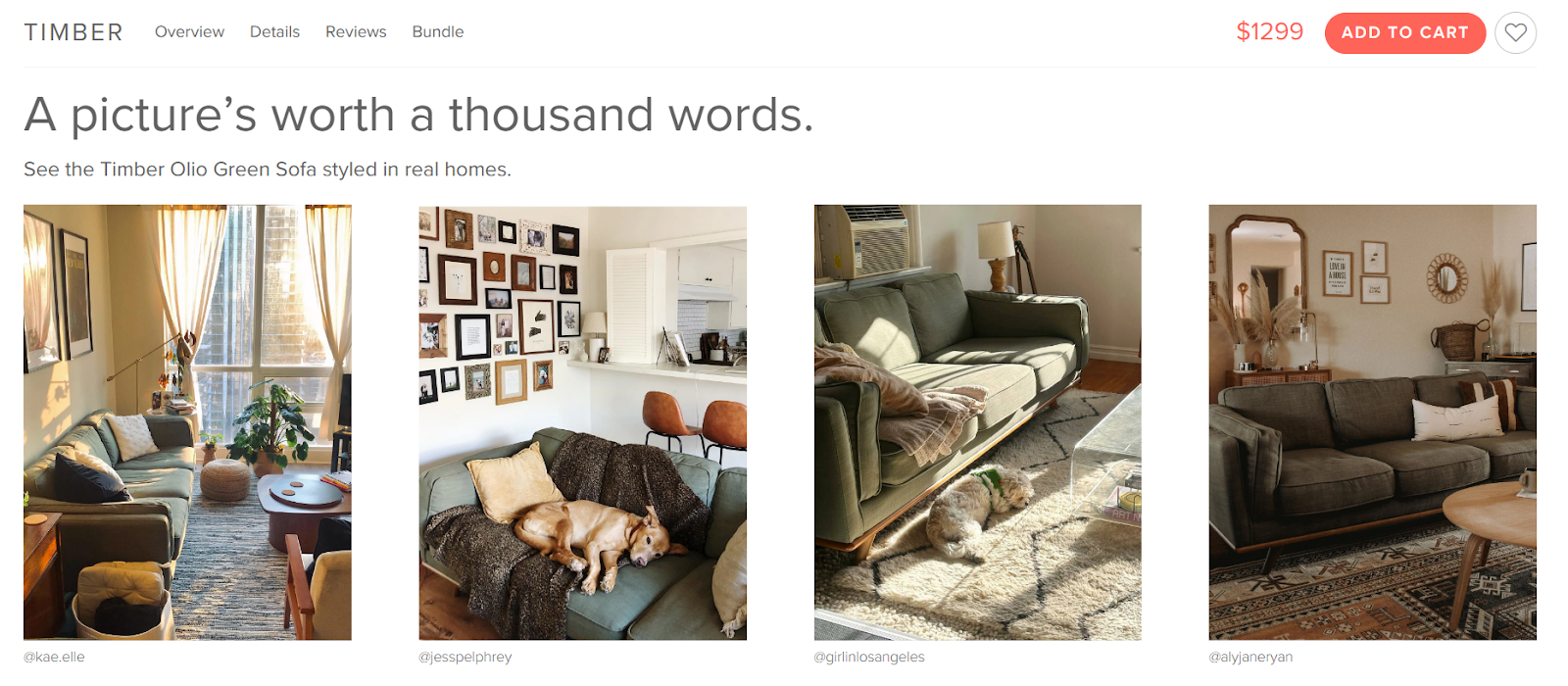
UGC in email marketing — If you want to stand out in a crowded inbox, you have to spice things up. And here’s where user-generated content can help. By including customer photos and reviews of your products in your emails, you can create familiarity and a sense of connection. Outer uses this approach to share customers’ feedback and persuade email subscribers to check out top-rated products.

UGC on social media — Using UGC on social media is much more than reposting content on your brand accounts. It requires careful planning and having a UGC strategy in place that aligns with your overall social media strategy. One brand that does this particularly well is Glossier.
The minimalist skincare and beauty brand consistently leverages UGC from its passionate community and reposts customers’ product reviews, makeup looks, and skincare routines, making the brand trustworthy and accessible in the eyes of its social media followers.
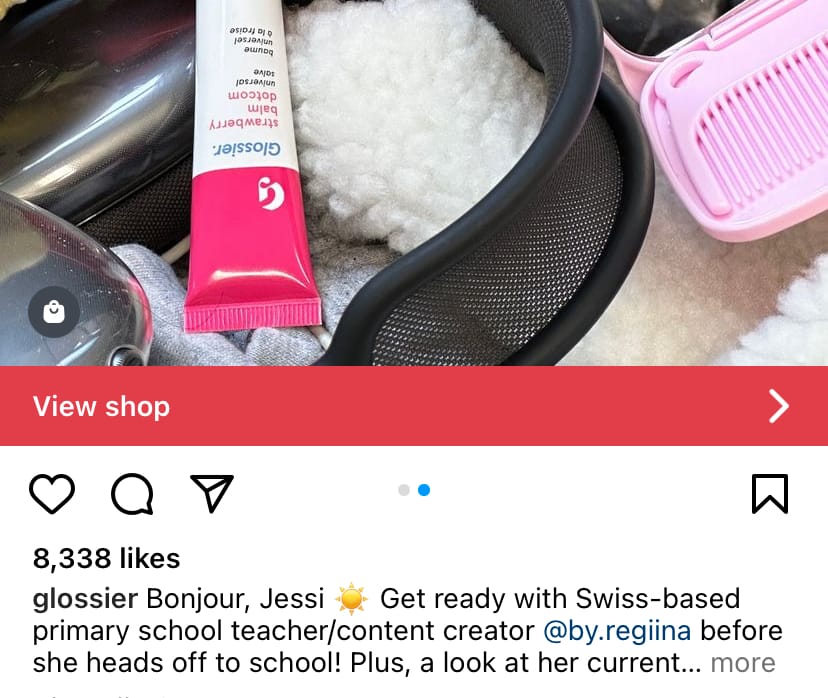
8. Build a strong community
A strong community can be the backbone of your UGC campaign. To build a community, you need to create a space where your audience feels valued, engaged, and inspired to share their experiences and feedback.
Sephora’s Beauty Insider Community is a space where members can ask questions, join challenges, and get recommendations from a community of like-minded individuals.

Creating a space where your audience feels comfortable and engaged is the key to a strong community. This is not a one-and-done activity. You have to seed your community with compelling content that sparks conversations and encourages participation.
You can encourage members to share stories, tips, and insights and contribute with their own experiences. This can be a great way to generate UGC from your community that you can later repurpose on other platforms.
Building a community can also be a great strategy for content creators who want to generate more reviews and testimonials. Selling online courses and running a community can create a synergy between the two, helping you get more sales but also social proof in the form of user-generated content.
9. Use CTAs strategically
One of the most important elements of a successful UGC campaign is having a clear call to action (CTA). Make sure your CTA is aligned with your campaign goals. Whether your goal is to encourage content creation, increase participation, drive website traffic, or boost sales, your CTAs should guide users to take the desired action.
Here are some CTA best practices to keep in mind:
- Use a clear CTA such as "Share your story," "Join the challenge," or "Tag us in your photos"
- Set the right expectations by explaining the value of sharing UGC and offering incentives
- Create a sense of urgency with a time-limited campaign
- Tailor your CTAs to suit different platforms
10. Monitor performance
Keep track of the user-generated content created as part of your UGC trend and amplify the best content by sharing it across your social media channels, website, and other platforms.
You can measure the success of your UGC campaign by tracking metrics such as engagement, reach, the number of user-generated content submissions, website traffic, and sales. Based on these insights, you can see what worked well and what can be improved for future UGC campaigns.
The Key to Successfully Using UGC: A Thriving Community
User-generated content powered by social media's growth has gone from throwing sparks to catching fire. Today, it’s an inevitable part of every brand’s content creation strategy, whether for physical or digital products.
Authentic content created by real customers or users is way more relatable and trustworthy than branded content. As a result, it drives engagement and fosters a sense of community. And the truth is that without a strong community, you can’t expect to have a successful UGC campaign.
So whether you’re a beginner to the ecommerce scene or a seasoned ecommerce store owner, joining Whop can help you to create a thriving community - and generate UGC as a result.
Whop is a social commerce site, and with Whop you can create your own online Whop Hub. Inside this hub, you can host a community chat, forum, blog, host giveaways, and more. Then, once this active community starts sharing social proof, you can use this in your UGC marketing campaign.
Plus, if you sell digital products, you can also sell these within your own hub! Check out Whop today and see how it can help you take your business further.


